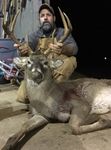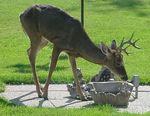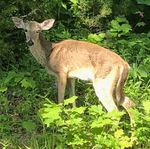Chronic Wasting Disease - Carroll County
←
→
Page content transcription
If your browser does not render page correctly, please read the page content below
W 832
Chronic Wasting Disease
Daniel Grove, Assistant Professor and Extension Wildlife Health Specialist
Department of Forestry, Wildlife and Fisheries
Background Transmission
In the late 1960s, mule deer in a Colorado research The most likely route of infection is via ingestion
facility, and later elk and mule deer in Wyoming, were of prions. Exposure may be from prions that have
the first to be identified exhibiting signs of what been deposited in the environment. Other behaviors
is now called chronic wasting disease (CWD). The such as mutual grooming amongst social groups or
animals progressively lost weight, stopped eating, interactions during rutting behavior may facilitate
had variable neurological deficiencies and eventually transmission. In utero transmission (mother to
wasted away over a prolonged period. Ultimately, the offspring during gestation) has been experimentally
disease was recognized in wild animals in Northern documented in muntjac deer, mule deer and elk.
Colorado and Southern Wyoming. In the 1980s the Transmission also may occur during parturition (at
disease agent was identified as a prion. Since that birth) or shortly thereafter during the initial maternal
time, the disease has slowly progressed across interactions with the fawn.
western states and now has been detected in 26
states, three Canadian provinces, Norway, Finland, Clinical Signs
Sweden and South Korea. Most of the clinical signs seen with CWD are
Definition the result of damage to the neurologic system
(brain, spinal cord). Often animals will first appear
CWD is the transmissible spongiform as thin with poor hair coats. As the disease
encephalopathy (TSE) of cervids. progresses ataxia (stumbling), incoordination
and hypersalivation (drooling) can be seen.
Causative Agent Unfortunately the signs of CWD are not specific
CWD is caused by a prion. A prion is essentially to just CWD. Confirmation of CWD infection can
a misfolded protein that exhibits infectious be done only by laboratory testing of the animal’s
properties. However, as compared to other brain or lymph nodes. It is important to note that
infectious agents including viruses, bacteria, fungi
and parasites, prions lack DNA or RNA. These
misfolded proteins are extremely environmentally
resistant and can persist in soil and other
substrates for decades.
Species Affected
CWD is known to infect members of the Cervidae
family. The disease has been found in wild white-
tailed deer, mule deer, elk, moose and caribou
populations. Captive populations of white-tailed
deer, mule deer, black-tailed deer and elk have also
been documented with the disease. Additionally,
muntjac have been experimentally infected.
Fallow deer are not known to be naturally infected
with CWD. CWD is not known to be naturally Deer infected with chronic wasting disease. Note poor hair
transmissible to cattle, sheep, goats or horses. Pigs coat, drooping ears and thin body condition.
have been infected in experimental studies. Photo provided by Arkansas Game and Fish Commission.
1clinically normal animals that are infected can be Disease Progression
CWD positive and shedding the prions into the
environment which warrants confirmatory testing on CWD is a slowly progressive disease. It is 100
both sick and healthy looking animals. The clinical percent fatal. Once they are infected with prions,
signs of CWD can be indications of other diseases animals will succumb to the disease. On average,
also. The only way to know that it is CWD is by post-infection, it takes 10-18 months before clinical
taking a sample from the animal and testing signs appear. Death usually occurs within months of
it for CWD. the appearance of clinical signs.
.
Deer infected with chronic wasting disease. Note thin
body condition. Despite appearing healthy, this 3.5-year-old buck
harvested in southwest Tennessee tested positive
Photo by Donald Savoy and provided by the Wisconsin Department of Natural
Resources
for chronic wasting disease.
North American Chronic Wasting Disease Distribution Map
2Where are the prions found in the body? The prions Testing
are found in highest concentrations in the nervous
system (brain, spinal cord) and lymphatic system Typically retropharyngeal lymph nodes (behind
(lymph nodes and gastrointestinal associated the pharynx) or brainstem is collected and tested
lymphatic tissue). It has been detected in the liver, for routine surveillance by state agencies. To date,
spleen, kidney, muscle, heart and antler velvet. there is no accurate live animal test; testing must
Additionally prions have been found in bodily be conducted on samples collected from animals
excretions and fluids such as saliva, urine, feces following death.
and blood.
What is the damage that prions cause in the body?
The most life-threatening damage caused by prions
replicating in an animal is the damage that happens
in the brain. Over time, the abnormally shaped
prions build up in the brain and lead to irreparable
brain cell deterioration, which results in the clinical
illness that we see (e.g., wasting, behavior changes).
The most common clinical signs associated with the
disease are a result of the decreased brain activity. A
vacuolization (hole formation) occurs when the cells
die, leading to the classic “spongelike” appearance
to the brain on microscopic examination.
Collection and location of retropharyngeal lymph node.
Blue Arrow = Lymph Node. Yellow Arrow = Pharynx (voice
box). Photo is taken from the ventral (bottom side of the
head).
Photo courtesy of the Michigan Department of Natural Resources.
Photomicrograph of brain infected with chronic wasting
disease. The clear areas are the vacuolization that occurs
as a result of CWD (arrow). The red staining is highlighting
the buildup of prion protein.
Photo courtesy Kevin Keel, Southeastern Cooperative Wildlife Disease Study.
CWD Surveillance
In general wildlife agencies utilize two methods of
surveillance. Targeted surveillance is conducted Retropharyngeal lymph node. Blue Arrow = Lymph Node.
year-round on sick acting, neurologic and Yellow Arrow = Pharynx (voice box).
roadkill animals. Hunter harvested surveillance
is conducted during hunting season. If you are Photo Courtesy of the Michigan Department of Natural Resources.
harvesting an animal in an area known to have
CWD, contact your state’s wildlife agency for
testing options. In Tennessee, contact the Tennessee
Wildlife Resources Agency (TWRA) for sampling
opportunities.
3Treatment Zoonotic Potential
There is no known treatment for CWD or any other The jury is still out as to whether CWD can cause
prion disease. disease in humans. To date there has been no
conclusive link between human disease and
Prevention consumption of CWD-infected animals. With that
There currently is no effective vaccine. Research is said, state wildlife agencies defer to public health
ongoing in an attempt to develop a vaccine. officials for recommendations. If hunters are hunting
in a known CWD endemic area it is recommended
Resistance that they have their deer tested for CWD. If the
animal tests positive for CWD, do not consume
About 5 percent of deer will have an apparent meat from that animal. For additional information
“resistance” to developing clinical disease. These regarding recommendations from the Centers for
deer still get infected, develop disease and die. The Disease Control and Prevention, visit CDC.gov.
“resistance” basically means there is a prolonged
period between infection and developing clinical If I see a sick deer or elk in Tennessee
disease. These animals are able to continue to shed what should I do?
prions into the environment but will do so for a
longer period of time before succumbing to the If you come across a sick animal, contact your local
disease. This prolonged shedding leads to a greater Tennessee Wildlife Resource Agency office to report
level of environmental contamination. the animal.
Immunity Additional CWD Resources
There is no known level of immunity to CWD. Tennessee Wildlife Resources Agency tn.gov/twra
Resistance does not equate to immunity. USGS National Wildlife Health Center usgs.gov/
Prions in the Environment centers/nwhc
Prions are nearly indestructible. They are not CWD Alliance cwd-info.org
destroyed by sunlight, heat, freezing or desiccation. Centers for Disease Control and Prevention cdc.gov
The only known methods to destroy prions are
through alkaline digestion or incineration at 1,000 Association of Fish and Wildlife Agencies CWD Best
C (1,838 F). Once shed into the environment, prions Management Practices fishwildlife.org/afwa-acts/
will remain infectious for over 15 years. For proper afwa-committees/fish-wildlife-health-committee
disposal of hunter harvested carcasses, check with
your state’s wildlife resource agency for current
recommendations.
W 832 07/19 19-0258 Programs in agriculture and natural resources, 4-H youth development, family and
consumer sciences, and resource development. University of Tennessee Institute of Agriculture, U.S.
Department of Agriculture and county governments cooperating. UT Extension provides equal opportunities
in programs and employment.
4You can also read
























































